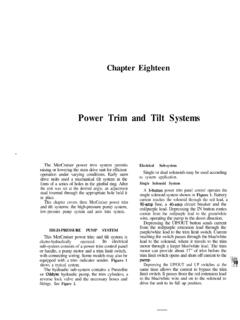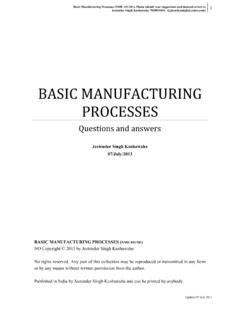Transcription of INTRODUCTION TO POLYMERS (RESINS)
1 INTRODUCTION TOPOLYMERS (RESINS)ByRuifeng (Ray) Liang, Facilities Reinforced Polymer Composite WorkshopFebruary 6, 2008, Sahara Star Hotel, Mumbai, IndiaIn connection withICERP 2008 FRP Institute2 ACKNOWLEDGMENTSThis presentation is based on the material included in the Tutorial on Polymer Composite Molding developed by Prof. Giuseppe R. Palmese, Center for Composite Materials, University of Delaware through the Michigan State University Intelligent Systems Lab under the NSF Technology Reinvestment Program in Liang appreciate the Tutorial for providing a good definition of fundamental concepts of polymer science and engineering, excellent description of liquid, injection, and compression molding of plastics and composites, and the relative advantages of various materials and Role of resins in FRP composites Thermosets vs.
2 Thermoplastics Advantage & limitations Polymer chemistry Chain & step polymerization Catalysts, inhibitors, accelerators Chain crosslinking/ curing Typical thermoset resin systems Polymer processing Polymer physics Glass transition Stress-strain curve Summary4 ROLE OF RESINS IN FRP COMPOSITESC omposite:- A heterogeneous combination of two or more materials reinforcing elements such as fibers, fillers binders such as resins or POLYMERS - These materials differ in form or composition on a There exists interface between these materials -compatibilityFiber: Load-bearing : Dissipate loads to the fiber network Maintain fiber orientation Protect the fiber network from damaging environmental conditionssuch as humidity and high temperature Dictates the process and processing conditions5 POLYMERP olymers are made up of a number of monomer repeat units, noting the number of repeat units as the degree of polymerization of a polymer , DP6 POLYMER CONFIGURATIONSL inear:long, linear chains, most thermoplastics, such as HDPEB ranched:long chains with arms coming from branch points, , LDPEN etwork.
3 Long chains linked together by crosslinking arms to form a network of chains, , cured thermosets, such as vinyl ester7 EFFECT OF MOLECULAR STRUCTURE ON END PERFORMANCE45002000 Ultimate Tensile Strength (psi)pipe, fittings,bottles, structural partsplastic bags,films, cables, (g/cm3)8050 Crystallinity (%)210-240190-220 Melting Point (C)HDPELDPEP roperty8 THERMOPLASTIC POLYMERST hermoplastic POLYMERS : soften, melt and flow upon heating, , LDPE, HDPE, PP, PS, PVC, Nylon, PMMA, PC, ABS, PETC haracteristics: PP Linear or branched structure Easy to process with application of heat Heat sensitive properties Individual polymer molecules are held together by weak secondaryforces: Van der Waal s forces Hydrogen bonds Dipole-dipole interactions9 THERMOPLASTIC POLYMERS (cont d)Advantages: Unlimited shelf life -won't undergo reaction during storage Easy to handle (no tackiness) Shorter fabrication time Recyclable - they undergo melt and solidify cycles Easy to repair by welding, solvent bonding, etc.
4 Postformable Higher fracture toughness and better delamination resistanceunder fatigue than epoxyDisadvantages: Poor creep resistance Poor thermal stability Poor melt flow characteristics (high viscosity ~ 1,000,000 cP)10 THERMOSET POLYMERST hermosets: do not flow upon reheating, unsaturated polyesters, vinyl esters, epoxies, phenol formaldehyde, urethaneCharacteristics: Upon application of heat, liquid resin becomes cured / rigid Cured polymer is less temp. sensitive than thermoplastics Crosslinked network structure (formed from chemical bonds, primary forces) exists throughout the part Crosslinking provides thermal stability such that polymer willnot melt or flow upon POLYMERS (cont d)Advantages: Low resin viscosity (~20 500cP) Good fiber wet-out Excellent thermal stability once polymerized Chemically resistant Creep resistantDisadvantages: Brittle (low strain-at-break) Long fabrication time in the mold Limited storage life at room temperature before curing Non-recyclable via standard techniques Molding in the shape of a final part - not postformableEpoxy12 POLYMER REACTIONST hermoplastics: polymerized prior to molding the final partThermosets.
5 Being polymerized via a polymerization reaction during the molding processThis classification is of particular importance to thermosettingsystems because the polymerization reactions between thermosets and thermoplastics are distinct in that:There are two fundamental polymerization reactions:13 POLYMER CLASSIFICATION VIA REACTION TYPEV inyl estersUnsaturated polyestersUrethaneAcrylonitrite-butadien e-styrenePhenol formaldehydePolymethyl methacrylateEpoxyPolyvinyl chloridePolyethylene terephthalatePolystyrenePolycarbonatePol ypropyleneNylonPolyethylenePolymers formed via step reaction: POLYMERS formed via chain reaction: CCC COOOC C OHHHHHHHOHn = 3 to 5 CCC COOOHHHOH+OHCCHHHHOH+OH214 CHAIN (OR ADDITION) POLYMERIZATIONI nitiators /Catalysts to initiate a free radical chain polymerization:Benzoyl peroxide (BPO)Dicumyl peroxide (DCP)Methyl ethyl ketone peroxide (MEKP), Cumene hydroperoxide (CHP)Upon heating, these peroxides dissociate to form two radicals which attack the monomer double bonds and add to them (addition).
6 Thisforms a reactive radical center which can propagate to form a and Retardersto suppress polymerization in order to improve processability and extend gel time/ shelf life Inhibitors and retarders differ in their effect on the conversion profile with time:Inhibitors stop all radical polymerization until consumed. Retarders stop only a portion of the radicals from polymerization is characterized by the presence of a few active sites which react and propagate through a sea of monomers, vinyl monomers15 CHAIN (OR ADDITION) POLYMERIZATIONE xamples of inhibitors and retarders used in free radical systems: Benzoquinone Hydroquinone Chloranil Diphenyl amine 2,4 Pentanedione (acetylacetone)Promoters and Accelerators to help initiate cure at room temperature:Cobalt naphthenate (CoNap) combination with MEKP Dimethyl aniline (DMA) combination with BPO and MEKP Gel time for a given resin depends on initiator level, promoter level, second promoter level, and temperature.
7 For example, with Derakane 411 VE MEKP 1%, CoNap , 0, gel time 21min @ 25 CMEKP 1%, CoNap , , gel time 180min @ 25 CNote: Additives (fillers) may affect resin cure RADICAL CHAIN POLYMERIZATIONT here are three important steps in free radical polymerizations:Initiation:Propagation:T ermination:Upon heating, the initiator (BPO, MEKP, DCP) dissociates to form two radicals which can attack the monomer double bonds and add to them. This forms a reactive radical center which can propagate to form polymer. Then radicals are terminated by combination or disproportionation.+ M17 STEP (OR CONDENSATION) POLYMERIZATIONNo special activation needed to allow a monomer to react withany nearby monomer. Condensation: water liberated when the polymer bonds form. Example: Polyester formation - The acid groups in diacids react with the alcohol groups in diols to form ester linkages.
8 Amide links - Amine groups react with carboxylic acidsCuring AgentsImportance of curing agents (also called crosslinking agents,hardeners, or catalysts): determines the type of curing reaction influences the processing cycle: viscosity versus time, gelation affects properties of the cured system: Tg, modulus, strengthExamples of curing agents for epoxies:aliphatic amine (DETA, AEP), aromatic amine (MPDA, MDA), cyclic anhydrides (NMA, PA)18 CHARACTERISTICS OF CHAIN AND STEP POLYMERIZATION REACTIONSR eaction mixture contains only monomer, high polymer, and a minuscule number of growing chainsAt any stage all molecular species are present in a calculable distributionLong reaction times give high yields but have little effect on molecular weightLong reaction times are essential to obtain high molecular weightsHigh polymer is formed at once--polymer molecular weight changes little throughout the reactionPolymer molecular weight rises steadily throughout the reactionMonomer concentration decreases steadily throughout the reactionMonomer disappears early in the reactionReaction occurs only at active centers by adding repeating units one at a time to the chainAny two molecular species present can reactChain PolymerizationStep Polymerization19 CROSSLINKING IN STEP POLYMERIZATIONC rosslinks are formed with the use of monomer of multi
9 Functional groupsFunctionality (f): the number of reactive groups of equal to 2: linear polymer f greater than 2: branched or crosslinked polymer Thermosets cured via this process includeEpoxiesUrethanePhenol formaldehyde20 CROSSLINKING IN CHAIN POLYMERIZATIONM onomers with two or more double bonds (for example, divinyl monomers) may lead to crosslinking. Examples of this type of systems: unsaturated polyesters, vinyl esters Vinyl ester with unsaturations is formed via step polymerization; The unsaturated sites are reacted with styrene to produce crosslinkedstructure via chain reaction with using peroxide OF THERMOSETTING RESINSA thermosetting system is set to cure when a crosslinked network of polymer chains is point: The onset of gelation when the material won t flow, molecular weight approaches for thermosetting resins is defined as a process for changing the properties of a resin via chemical reaction with evolution of heat & any volatiles, increase in viscosity, gelation, and AND VINYL ESTER RESINSR esin/ pre-polymer/ oligomer- 40 to 100% (typically 55-65%) Provides polymer properties, including modulus, toughness, glasstransition temperature, and diluent or monomer(styrene commonly)- 0-60% (typically 35-45%) Viscosity control Lower cost Improve wetting behavior Initiator (catalyst)
10 --1 to 3% Peroxide necessary to begin chemical reaction Promoter to Speed up and enhance the cureInhibitors to Aid in processing Improve shelf life23 EPOXY RESINThe above most widely used epoxy resin is based on diglycidyl ethers of bisphenol A (DGEBA). Characteristics of epoxies Excellent chemical resistance Low shrinkage Two component system (for example, amine to epoxy ratio 1:2) Good adhesion to many substrates More difficult to process than polyesters and vinyl esters Vast selection of crosslinking agents or hardeners Control over final properties and processabilityTypes of curing agentsAmine: Diethylene triamine (DETA), Aminoethyl piperazine (AEP)Meta-phenylenediamine (MPDA), Methylene dianilene (MDA)Anhydride: Nadic methyl anhydride (NMA), Phthalic anhydride (PA)24 THERMOPLASTIC PROCESSINGT hermoplastic processing window in temp-pressure chart: The lower pressure limit is set by the short shot condition; the upper limit is the point where flashing occurs, which is polymer leaking out of the mold at the seams.







